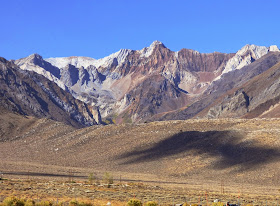About 760,000 years ago, a magma chamber composed of silica-rich rhyolite magma exploded in a titanic eruption that sent about 150 cubic miles (600 cubic kilometers) of ash across the western United States. Ash layers are still recognizable in places like Kansas and Nebraska, and in the immediate area around the blast, volcanic ash and tuff occur in deposits hundreds of feet thick spread over dozens of square miles. So much material was lofted into the atmosphere that the crust collapsed into a gigantic hole 10 miles (16 km) wide and 20 miles (32 km) long, and thousands of feet deep; it's called the Long Valley Caldera
For me, it took an overflight at 30,000 feet to even begin to see the full scale of the blast. Just about all the landscape in the picture above is covered with volcanic tuff. A freeway climbs the slope on the left side of the picture, but is barely visible. I've added labels in the picture below to highlight the location of the caldera, which was obscured by clouds
In this mini-blog series, we've been exploring the Sierra Nevada beyond the very limiting confines of Yosemite Valley and Yosemite National Park. Our fall field studies trip took us down the Owens Valley and some of the lands east of the Sierra Nevada crest, including this gigantic hole that actually breached the mountain wall. The lower section of the crest allows Pacific storms to blow through, dropping prodigious amounts of snow, especially on Mammoth Mountain, a volcano that developed on the edge of the caldera thousands of years after the climactic blast. Many thousands of years later, it was decided that this was a perfect place to put a ski resort.
 |
| The Owens River Gorge on the margin of the Long Valley Caldera. |
 |
| The edge of the Long Valley Caldera along the Sierra Nevada crest. |
On May 18, 1980, Mt. St. Helens exploded with unexpected ferocity, killing nearly four dozen people. The U.S. Geological Survey was caught off guard in terms of predicting the moment of the eruption, as they did not yet understand the dynamics of Cascades volcanoes. Only a week or so later, a series of four magnitude 6 earthquakes struck the Mammoth Lakes region, injuring a number of people and causing several million dollars of damage. Many more earthquakes followed, and with the location of the epicenters being within the caldera, the geologists became concerned. They deployed more instruments in the region, and discovered that the floor of the caldera had been rising, some 10 inches between 1979 and 1980. Even more disturbing was the discovery that the earthquakes were migrating, and becoming more shallow, ultimately reaching a mere 7,000 feet or so beneath the surface. New steam vents were opening up (although geothermal activity has always been present). As I say to my students on their first day of class, "You've been geologists for 45 minutes now, what do YOU think was going on?"
 |
| The floor of the Long Valley Caldera with Crowley Lake, and Glass Mountain on the far rim of the caldera. |
At the time, the USGS had a warning system in place, with three tiers:
NOTICE OF POTENTIAL HAZARD-Information on the location and possible magnitude of a potentially hazardous geologic condition. However, available evidence is insufficient to suggest that a hazardous event is imminent or evidence has not been developed to determine the time of occurrence.
HAZARD WATCH-Information, as it develops from a monitoring program or from observed precursors, that a potentially catastrophic event of a generally predictable magnitude may occur within an indefinite time (possibly months to years).
HAZARD WARNING-Information (prediction) as to the time, location, and magnitude of a potentially disastrous geologic event.
Give it some thought...given the intense geologic activity, what would you do? Would you notify the civic authorities? Would you go to the media? Is it possible that the media might report the facts as they are known, or would there be a tendency to go overboard on their coverage? Keep in mind the difference between 1983 and the present day when numerous cable news networks have to keep talking 24 hours a day. Or, would you keep things quiet, and hope that the geologic activity would die down without any catastrophes occurring? What happens if you quash your findings, and an eruption takes place? What is your liability in the deaths and injuries that result? Is there an easy answer here?
What would you do?
And what finally happened?
Find out in part 2!




Thankfully the Italian seismologists were released http://www.nature.com/news/italian-seismologists-cleared-of-manslaughter-1.16313
ReplyDeleteWe are having a similar problem with the wilful ignorance of flood in our local area by councils.
Rob Australia
Gary, I commented earlier about the rain shadow effect at Bodie. you just put another piece in the puzzle for me. I look at google maps terrain view a lot, but it never occurred to me that Mammoth has a lot of snow for being east of the crest. Google earth in oblique view clearly shows the passage through the crest that bypasses the rain shadow effect. A great post and a great cliffhanger for part 2.
ReplyDeleteI would tell the authorities about it. If they didn't want to help me with telling all the others about the problem then I would tell them myself but quietly. If I wanted to tell the media secretly to help me tell the others I know they would probably side with the authorities and turn me in but I know it was worth a shot.
ReplyDelete